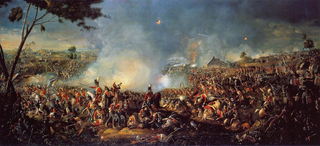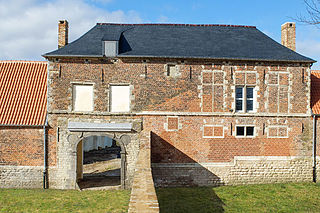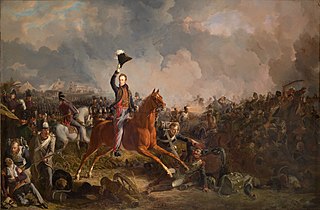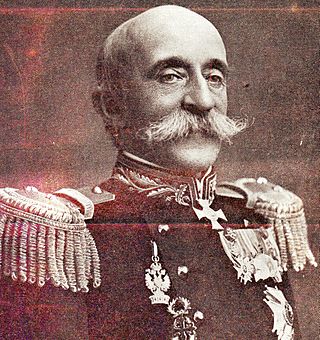Related Research Articles

The Battle of Waterloo was fought on Sunday 18 June 1815, near Waterloo, marking the end of the Napoleonic Wars. The French Imperial Army under the command of Napoleon I was defeated by two armies of the Seventh Coalition. One of these was a British-led force with units from the United Kingdom, the Netherlands, Hanover, Brunswick, and Nassau, under the command of field marshal Arthur Wellesley, Duke of Wellington. The other comprised three corps of the Prussian army under Field Marshal Blücher; a fourth corps of this army fought at the Battle of Wavre on the same day. The battle was known contemporarily as the Battle of Mont Saint-Jean in France and La Belle Alliance in Prussia.

The Battle of Ligny, in which French troops of the Armée du Nord under the command of Napoleon I defeated part of a Prussian army under Field Marshal Blücher, was fought on 16 June 1815 near Ligny in what is now Belgium. The result was a tactical victory for the French, but the bulk of the Prussian army survived the battle in good order, was reinforced by Prussian troops who had not fought at Ligny, and played a role two days later at the Battle of Waterloo. Ligny was the last victory in Napoleon's military career.

Château d'Hougoumont is a walled manorial compound, situated at the bottom of an escarpment near the Nivelles road in the Braine-l'Alleud municipality, near Waterloo, Belgium. The site served as one of the advanced defensible positions of the Anglo-allied army under the Duke of Wellington, that faced Napoleon's Army at the Battle of Waterloo on 18 June 1815.

The Battle of Quatre Bras was fought on 16 June 1815, as a preliminary engagement to the decisive Battle of Waterloo that occurred two days later. The battle took place near the strategic crossroads of Quatre Bras and was contested between elements of the Duke of Wellington's Anglo-allied army and the left wing of Napoleon Bonaparte's French Armée du Nord under Marshal Michel Ney. The battle was a tactical victory for Wellington, but because Ney prevented him going to the aid of Blucher's Prussians who were fighting a larger French army under the command of Napoleon Bonaparte at Ligny it was a strategic victory for the French.

The Waterloo campaign was fought between the French Army of the North and two Seventh Coalition armies, an Anglo-allied army and a Prussian army. Initially the French army had been commanded by Napoleon Bonaparte, but he left for Paris after the French defeat at the Battle of Waterloo. Command then rested on Marshals Soult and Grouchy, who were in turn replaced by Marshal Davout, who took command at the request of the French Provisional Government. The Anglo-allied army was commanded by the Duke of Wellington and the Prussian army by Field Marshall Graf von Blücher.

This is the complete order of battle for the four major battles of the Waterloo campaign.

David Hendrik, Baron Chassé was a Dutch soldier who fought both for and against Napoleon. He commanded the Third Netherlands Division that intervened at a crucial moment in the Battle of Waterloo. In 1830 he bombarded the city of Antwerp as commander of Antwerp Citadel during the Belgian Revolution.

The following units and commanders fought in the Battle of Quatre Bras on 16 June 1815 at Quatre Bras in the Belgian region of Wallonia. The numbers following each unit are the approximate strengths of that unit.

Prince Carl Bernhard of Saxe-Weimar-Eisenach was a distinguished soldier, who, in 1815, after the congress of Vienna, became colonel of a regiment in the service of the king of the Netherlands. He fought at the Battle of Quatre Bras and the Battle of Waterloo where he commanded the 2nd Brigade of the 2nd Dutch Division, and later became a Chief Commander of the Royal Netherlands East Indies Army.

Jonkheer Albert Dominicus Trip van Zoudtlandt was a Dutch lieutenant-general of cavalry who headed the Dutch heavy cavalry brigade at the Battle of Waterloo.

Willem Frederik count of Bylandt or Bijlandt was a Dutch lieutenant-general who as a major-general commanded a Belgian-Dutch infantry brigade at the Battle of Quatre Bras and the Battle of Waterloo.

Jean Victor Constant de Rebecque or Jean Victor de Constant Rebecque was a Swiss mercenary and member of the house of Constant de Rebecque who distinguished himself in Dutch service. As chief of staff of the Netherlands Mobile Army, he countermanded the order of the Duke of Wellington to evacuate Dutch troops from Quatre Bras on the eve of the Battle of Quatre Bras, thereby preventing Marshal Michel Ney from occupying that strategic crossroads.

Hendrik George, Count de Perponcher Sedlnitsky was a Dutch general and diplomat. He commanded the 2nd Netherlands Division at the Battle of Quatre Bras and the Battle of Waterloo.

François de Bas was a Dutch general and military historian. He almost single-handedly founded the military-history section of the Dutch General Staff. He co-authored major historical works on the Dutch States Army and the Campaign of 1815, which climaxed with the Battle of Waterloo. The latter work is still the authoritative source on the Dutch-Belgian role in that battle, because it contains copies of after-battle reports of Dutch officers who participated in the battle, the originals of which were lost in a Royal Air Force bombardment of the Dutch Army archives in 1945.

Pieter Hendrik van Zuylen van Nijevelt was a Dutch count and baron who served as a general in the French and Dutch armies during the Napoleonic era and later. He was present at the Battle of Waterloo in 1815 as chief of staff of the 2nd Dutch Division.

Hendrik Detmers was a Dutch military officer who played an important part in the Battle of Waterloo as a colonel, commanding a brigade.

The Waterloo campaign commenced with a pre-emptive attack by the French Army of the North under the command of Napoleon Bonaparte. The first elements of the Army of the North moved from their peacetime depots on 8 June to their rendezvous point just on the French side of the Franco-Belgian border. They launched a pre-emptive attack on the two Coalition armies that were cantoned in Belgium—the Anglo-allied army under the command of the Duke of Wellington, and a Prussian army under the command of Prince Blücher.
The Belgian 7th Line Infantry Battalion was a Belgian/Southern Netherlands regular (line) battalion commanded by lieutenant-kolonel F.C. van den Sande which fought with distinction during the Waterloo Campaign of 1815.

The Indies Brigade or Indian Brigade, also referred to as the Dutch Indies Brigade or Netherlands Indies Brigade, was a Dutch-Belgian military unit which took part in the Waterloo Campaign and subsequent invasion of France in 1815. It was sent to the Dutch East Indies together with the Commissioners-General of the Dutch East Indies after the Hundred Days to fulfill its mission as the core of the future Royal Netherlands Indies Army in October 1815.
Alexandre Charles Joseph Ghislain Count d'Aubremé was a Southern Netherlands general in the service consecutively of the First French Republic, the Batavian Republic, the Kingdom of Holland, the First French Empire, the Sovereign Principality of the United Netherlands, and the United Kingdom of the Netherlands. He commanded the 2nd brigade of the 3rd Netherlands division at the Battle of Waterloo. He served as Minister of War under king William I of the Netherlands.
References
- ↑ Haythornthwaite, p. 161
- ↑ De Bas and Wommersom, Quatre Bras, p. 196
- ↑ De Bas and Wommersom, Quatre Bras, pp. 491-496
- ↑ De Bas and Wommersom, Quatre Bras, p. 541 and note 2 on p. 541
- ↑ De Bas and Wommerson, Waterloo, pp. 23-24
- ↑ De Bas and Wommersom, p. 87
- 1 2 De Bas and Wommersom, Waterloo, p. 88
- ↑ De Bas and Wommersom, Waterloo, p. 124
- ↑ De Bas and Wommersom, Waterloo, pp. 134-136
- ↑ Pawly, p. 39
- ↑ Baker-Smith, p. 126
- ↑ Wellington, A. W. (1863). Supplementary Despatches and Memoranda of Field Marshal Arthur, Duke of Wellington, K. G. Vol. 10. p. 17. Retrieved 21 April 2023.
- ↑ Hussey, p. 150
- ↑ De Bas and Wommersom, Quatre Bras, pp. 436-443, 465
- ↑ Summerville, p. 76
- ↑ Muir, p. 353
- ↑ Atkinson, p. 509
- ↑ Montholon
- ↑ White